I can’t say that I really went to Nepal with a plan. I knew that I was going for just over two months; I knew there were a lot of bus rides; I knew I wanted to go kayaking and I knew, deep down, that I really, really wanted to run the Thuli Bheri.
Located in the far western reaches of Nepal in a region known as the Dolpa District, the Thuli Bheri promised days of continuous class IV+ whitewater with beautiful scenery. Only problem? It takes a casual 20 hours by bus and then an hour by plane followed by an hour in a jeep and definitely some logistical luck just to get to the put-in from Kathmandu. Did I mention there was a late monsoon season that Fall, meaning that all the rivers were experiencing higher than normal water levels for this time of year? Oh, and I was travelling by myself. Though I had essentially written it off as a pipe dream, a small part of me held on to the idea that it could, conceivably, happen.
And then there was a Facebook post—I know there are a lot of opinions out there about social media, but what a fantastic tool for when you’re trying to meet people in foreign countries where you don’t speak the language and you’re trying to do an obscure sport that people think you’re absolutely insane to even be attempting. Lukas (Austria) posted on the Nepal Kayak Club page asking if anyone was interested in a Thuli Bheri trip in early November. Naturally, I immediately Facebook stalked him. When I came away somewhat satisfied that he was a solid kayaker capable of running the whitewater, I sent him a message. And then, there were two… which still isn’t enough to make a mission like this possible for normal humans like us, but it was certainly a step in the right direction. We talked briefly and then agreed that we would each individually look for people to join and that we would meet up at the Modi Khola Express III, a yearly kayaking event held to promote free-flowing rivers in Nepal. If you’re ever in Nepal in October/November, you should definitely go!
Lucky for us, the race was the perfect place to meet the three other people who would make up the rest of our team; Leon (Switzerland), Fran (Germany), and Liam (US/Nepal). For a mission like this, you need to make sure that the people you’re going with, 1. Can actually paddle the whitewater, and 2. Aren’t assholes. We were all relatively sure that everyone on the team fit the bill.
Though we were originally planning on spending the next three weeks paddling together in other parts of Nepal to get used to each other’s boating styles and see some of the other rivers before heading out on our adventure, everything changed almost immediately, as is often the case when travelling. At the post-race celebration, Fran’s finger had an unfortunate encounter with a broken beer bottle, slicing deep into the tissue and requiring Steri-strips. Though the cut was clean and we dealt with it quickly, we were still faced with the reality that she had an open wound and we were in a country with rivers that would not be readily considered “clean”. With the high possibility that if she paddled before it was healed she would get an infection, Fran stayed in Pokhara and sat out our next planned adventure; an overnighter on the Upper Kaligandaki. While it is a simple overnighter, I managed to make it very exciting by having an anaphylactic reaction to peanuts in the granola the second morning of the trip and getting subsequently evacuated via helicopter out of the canyon. That is a whole other story in and of itself. Needless to say, we returned to Pokhara tired.
With Fran now experiencing cabin fever and none of us wanting to stay in Pokhara any longer, Liam headed back to Kathmandu to do some work. Fran, Leon, and I headed to the Marshyangdi (one of the cleaner rivers). The section ended up being significantly harder than expected; a taxi driver tried to steal all of our kayaks and gear and fishermen woke us up at three in the morning demanding water but, on the whole, we had a wonderful overnighter on a beautiful river. We then headed East for three days and paddled on the Balephi and Bhote Koshi before returning to Kathmandu to start our mission on the Thuli.
With a chartered minibus, we made the six-hour journey from Kathmandu back to Pokhara. We spent the next day grocery shopping, making sure we had all of the necessary layers, downloading maps, ensuring we had enough safety equipment, and acquiring a general knowledge of the river. Finally, we were on our way. At 4:30 AM, we took two taxis to the public bus station where we loaded up on a bus and started our 12-hour journey to Nepalgunj. We arrived in the evening, haggard and sick of Bollywood songs and music videos.
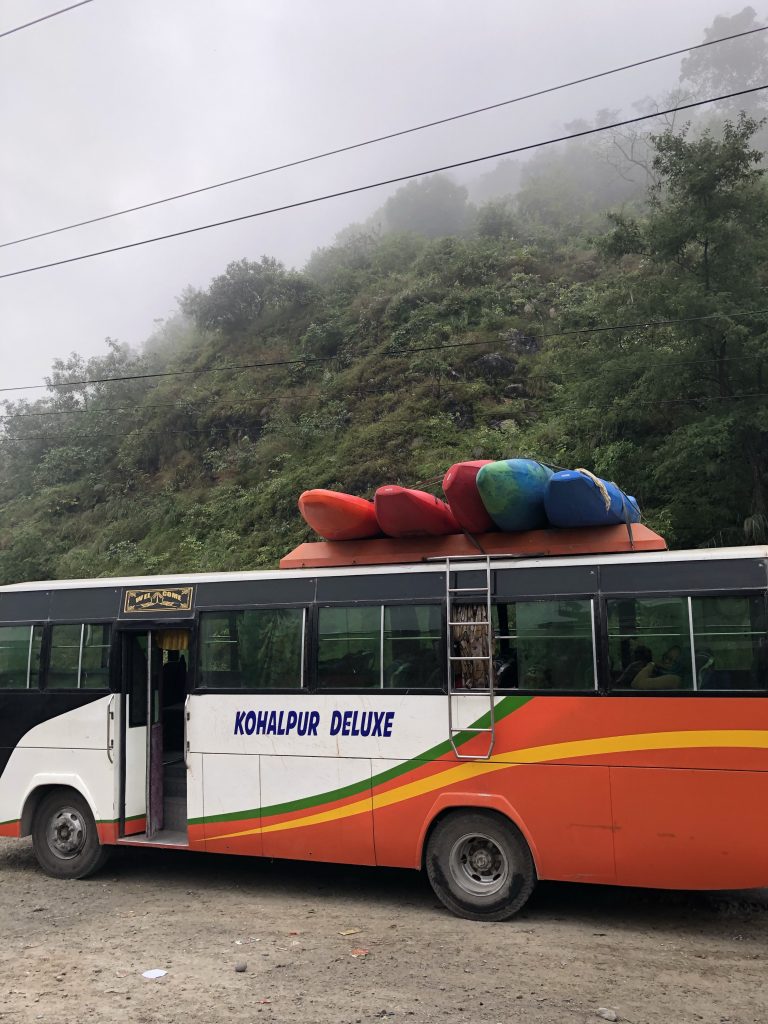
Following an interesting night’s sleep, we headed to the airport at 5 to catch our chartered 6 AM flight to Juphal. These flights are known to be relatively unreliable due to weather, stranding kayakers in Nepalgunj with nothing to do except drink and use the shitty internet. Thankfully, our flight went off without a hitch. I recommend finding someone who knows someone who works in the airport; it made our lives a lot easier. As the sun crested and illuminated our surroundings, we were greeted with stunning mountain and beautiful high desert landscapes. Upon landing, however, we were greeted by the lovely airport security officers/police who requested our permits. Though Liam had called multiple agencies to double-check that the section of river we were paddling didn’t require any type of permit, the fact that we needed a permit to even land in the Dolpa district had never been mentioned and was unknown to us prior to literally sitting on the tarmac with all of our shit and the Himalayas surrounding us. So, Liam got a ride to the nearest town center in Dunai and we waited in the village of Juphal drinking yak milk tea and coffee while sitting on the village roofs overlooking the valley.
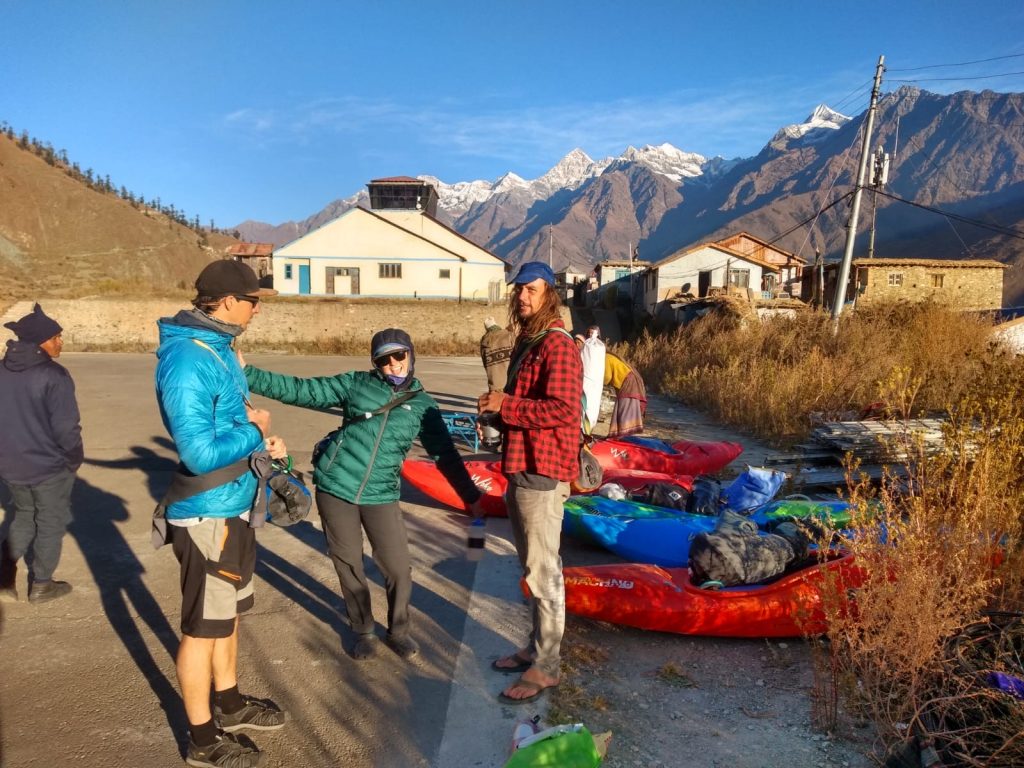
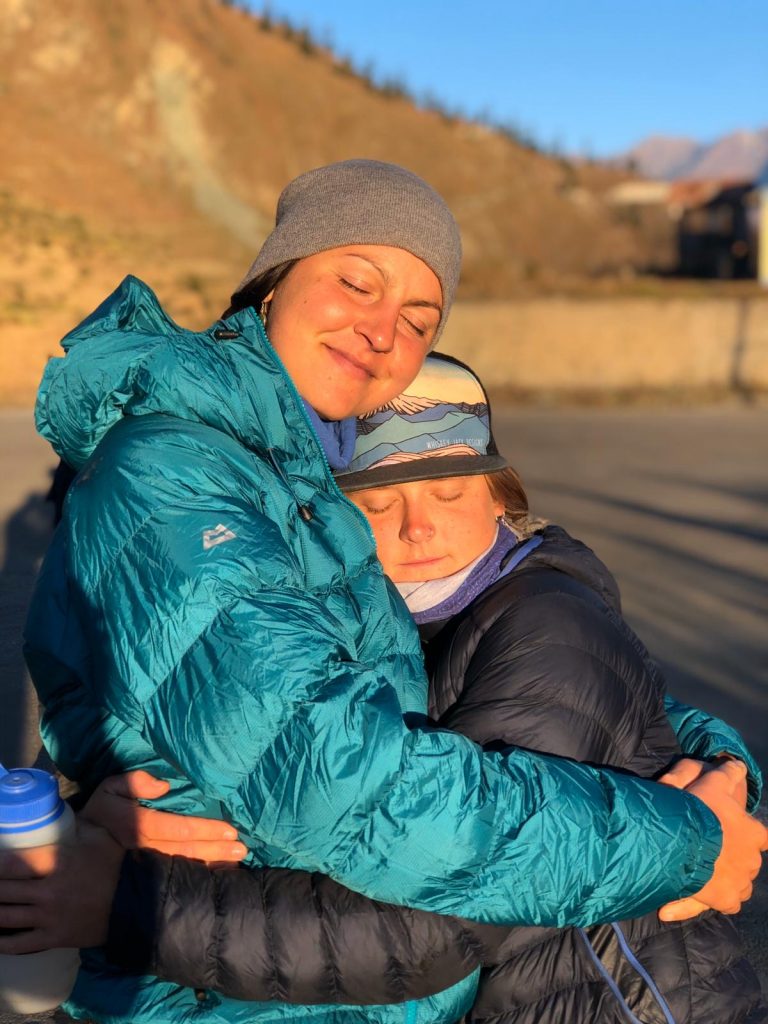
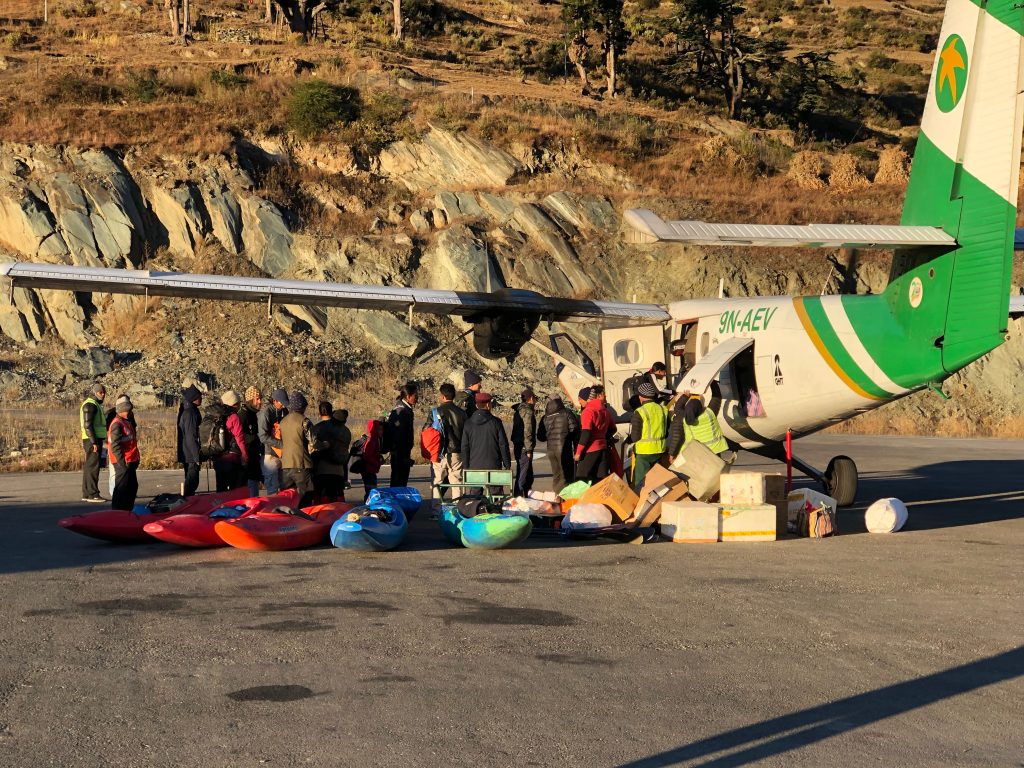
After a few hours, Liam told us it would still take him some more time to wade through the red tape that inherently exists in any sort of Nepali paperwork, so we loaded up in a jeep and drove down to the river. It’s a new road, and ‘road’ might be a generous term for the strip of dirt we took down the hillside, but we did do it in a car so I guess that’s the qualifier. We drove up the river a few miles and stopped at Suligad which is right on the border of the national park; to put in any higher than this, you do technically need a permit. Liam was finally able to join us around 1 pm and we pushed off and headed downstream… Not before losing an iPhone in the Jeep, getting yelled at by the Nepali Military for being too close to a bridge, and then finding the iPhone in the same Jeep as it passed us again around an hour later bringing Liam back down to us from Dunai. You can’t make this shit up.
The first few kilometers of the Thuli are beautiful and relaxed. Flanked by pine trees and huge mountains in the distance, the river is braided and wide with a few riffles here and there. The riffles seem to be primarily created by upstream wind that appears to be ever-present according to almost everyone I’ve talked to that has run this river. I can’t speak for anyone else, but I was still amazed that it was actually happening and that we were finally on the river. After a few kilometers, we passed through a constriction created by beautiful cliffs and a small suspension bridge. Beyond this, the whitewater picked up and we were shortly confronted with our first portage: a long, complicated boulder garden. If not for the sticky hole in the middle, we all agreed that this rapid would have been amazing to paddle; not sure what it looks like at other water levels. Past the portage, the river proceeds with continuous class III+ for a few kilometers before Golden Canyon begins. We camped shortly before the start of the canyon section as we weren’t sure if there would be good camping once we started but, as we found out the next day, there was plenty.
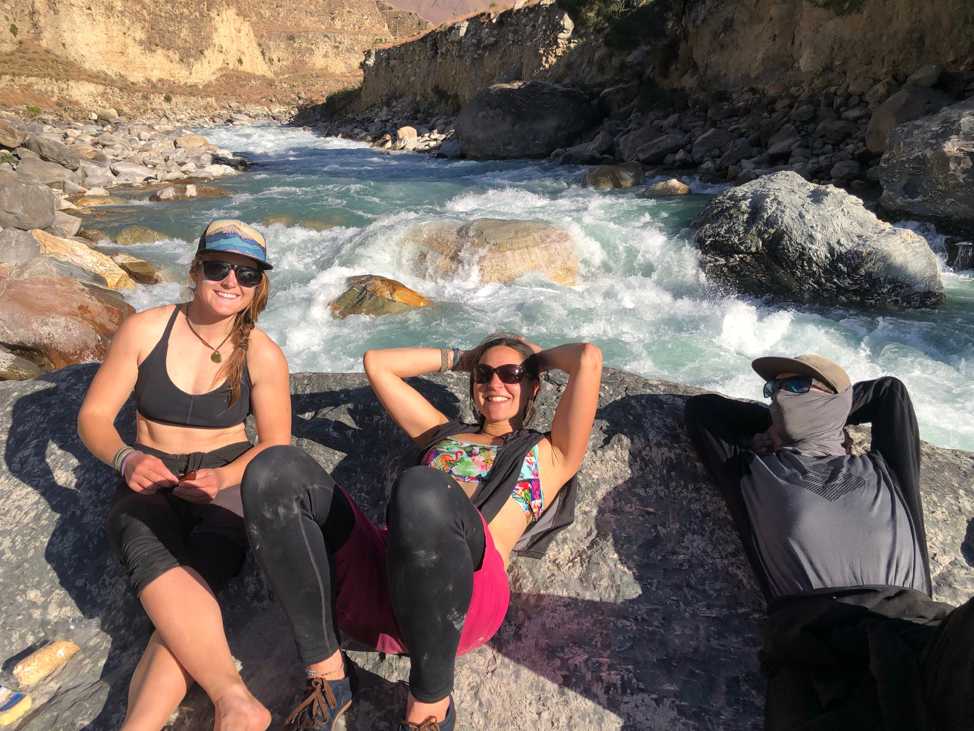
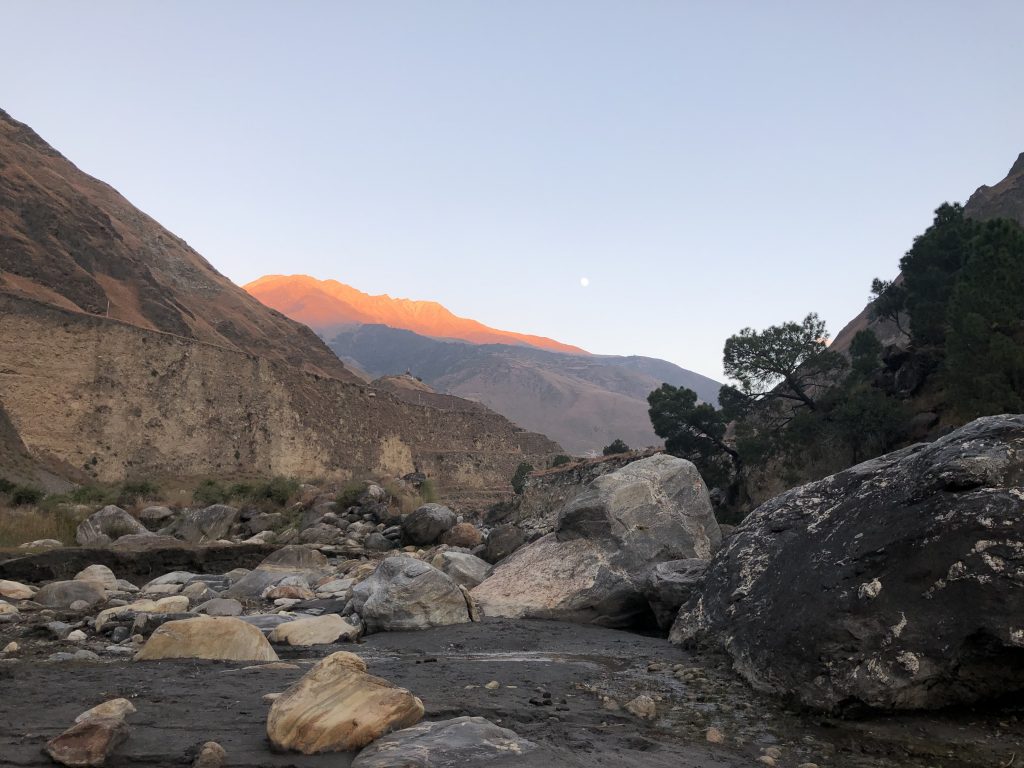
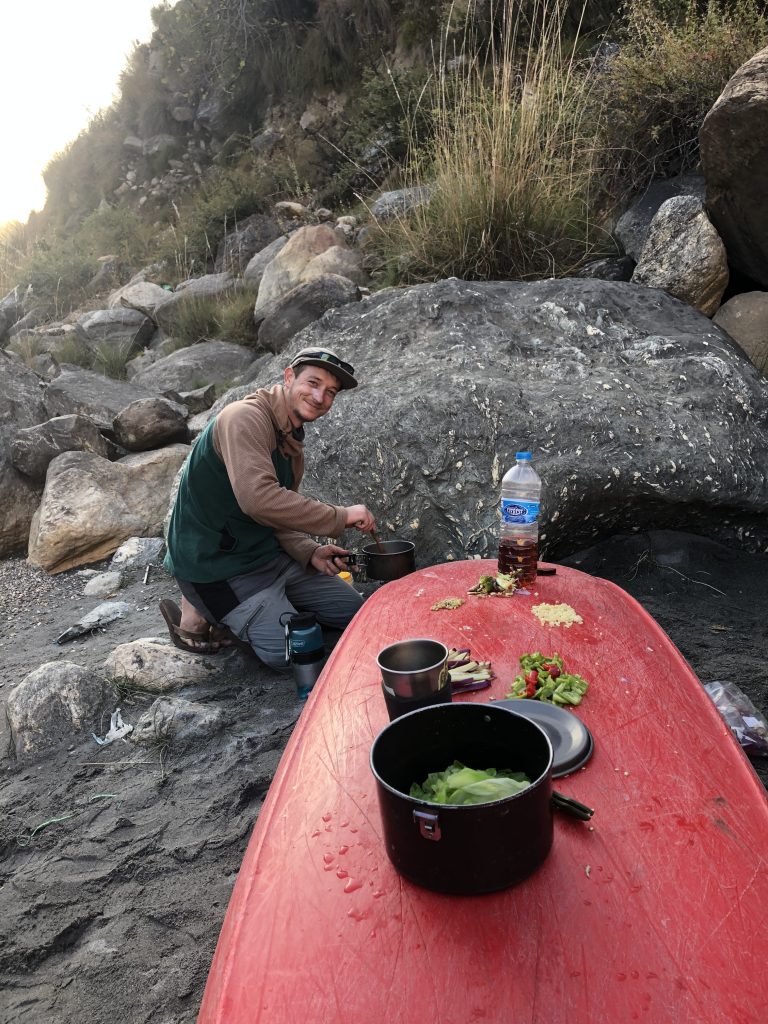
The next morning, we woke up early and pushed off the beach around 9:30, entering Golden Canyon almost immediately. The canyon is aptly named as the canyon walls literally glitter and glow in the light. It’s incredible. From the time we put on the water to the time we chose a camp it was non-stop class IV/IV+ whitewater. We came to one portage early in the morning that had a line down the left side, but didn’t seem very attainable with fully loaded boats, so we portaged around it on river left. We continued through more class IV and came upon another portage just before lunch. We ate lunch at the iconic drop of Golden canyon which is extremely picturesque. Massive golden boulders are strewn throughout bright blue water with the perfect spot to take a picture atop a large boulder as people make their way through the last part of the rapid. After lunch, we continued running class IV all the way to camp around 3:30, a few kilometers before the end of Golden Canyon. We didn’t cover nearly as much distance as we wanted, only paddling around 7 kilometers, which put us behind schedule by about a day. We made a fire that night and revelled in the whitewater we’d paddled… and Fran and Leon tried s’mores for the first time.
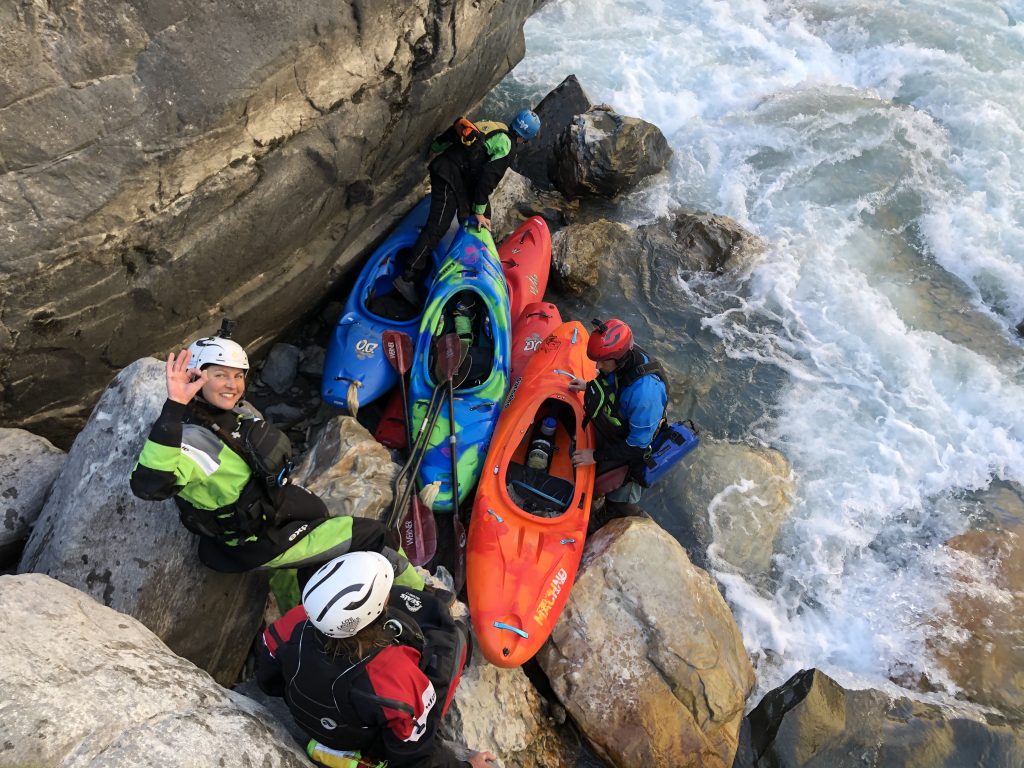
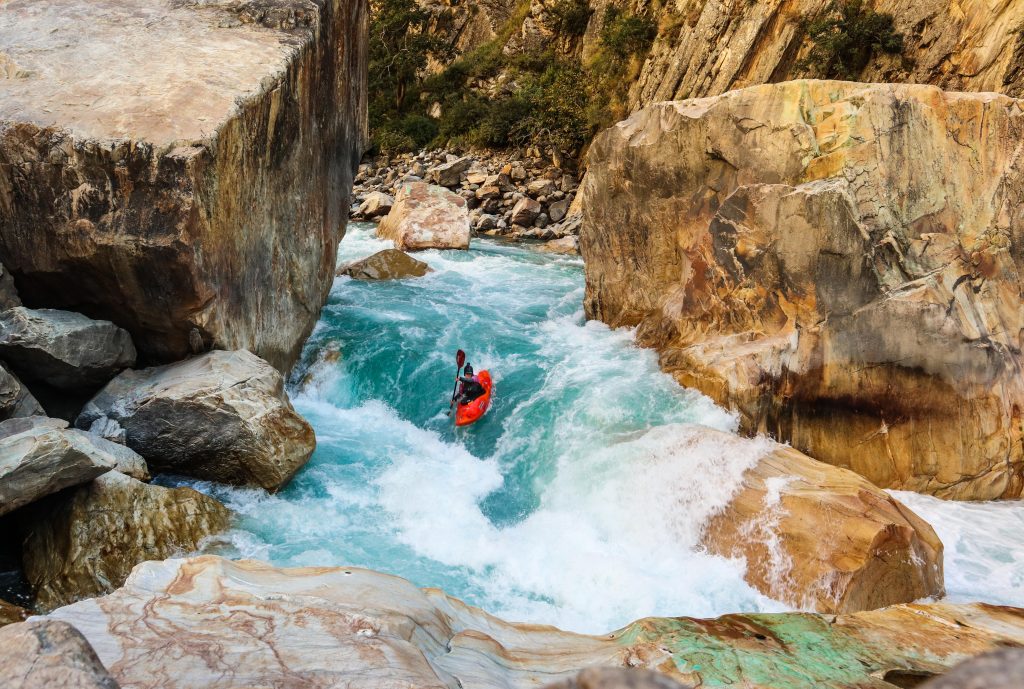
On day 3 we put on around 9:30 again and were immediately greeted with the last of the class IV/IV+ of Golden Canyon. Though we originally thought that the whitewater would slow down for a bit once we exited the canyon, we were quite mistaken. As we rounded the bend to the right just after the canyon walls dropped, we entered a long, braided, steep, very continuous boulder garden with eddies that were few and far between. This entire section had really high pin potential and was radically different from the entire canyon above. This continued for a few kilometers; no pool drop, just one continuous rapid. After the steep boulder garden, we saw the first class III section we had seen since the beginning of the trip and then we hit a long section of flat water. The kind of flatwater above the infamous Jacob’s ladder on the North Fork of the Payette. The kind of ominous flat water that gives you butterflies because you know something insanely steep and big and probably hard is in front of you. We then dropped into more steep boulder gardens interspersed with some steep, channelized rapids. In total, we ended up portaging four or five rapids with Liam, Leon, and Lukas firing up some of them and the entire group portaging at least two together. I don’t remember the lines through any of them but I do remember that there were potential lines through most of them, they were just really, really tight and would have been very challenging to execute. We camped just above Tri Beni and got there around 4. In total, we were able to cover around 20 kilometers, which was more than we anticipated.
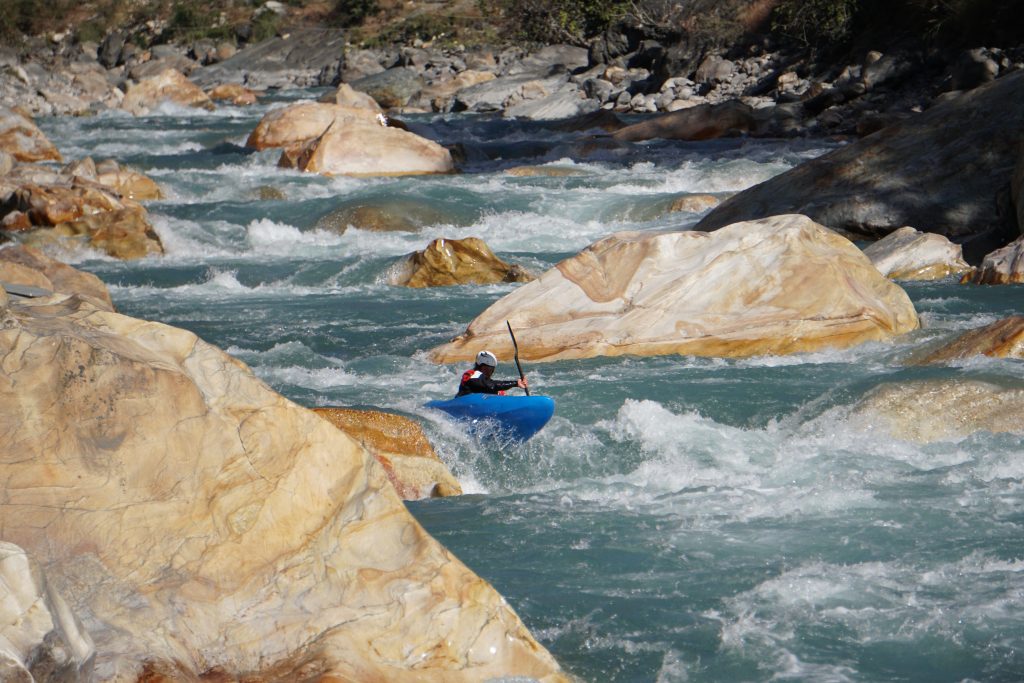
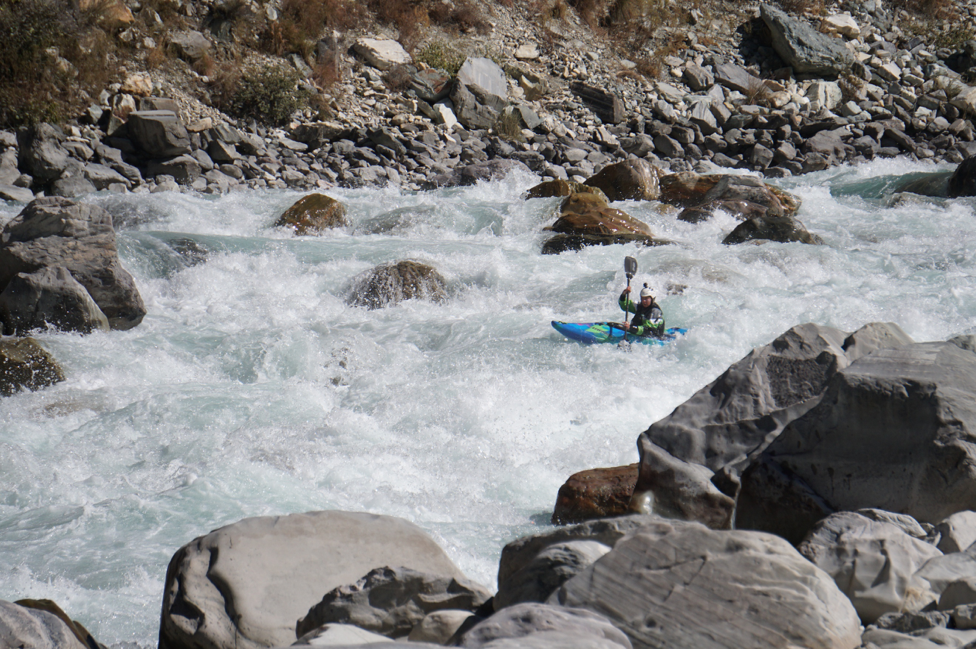
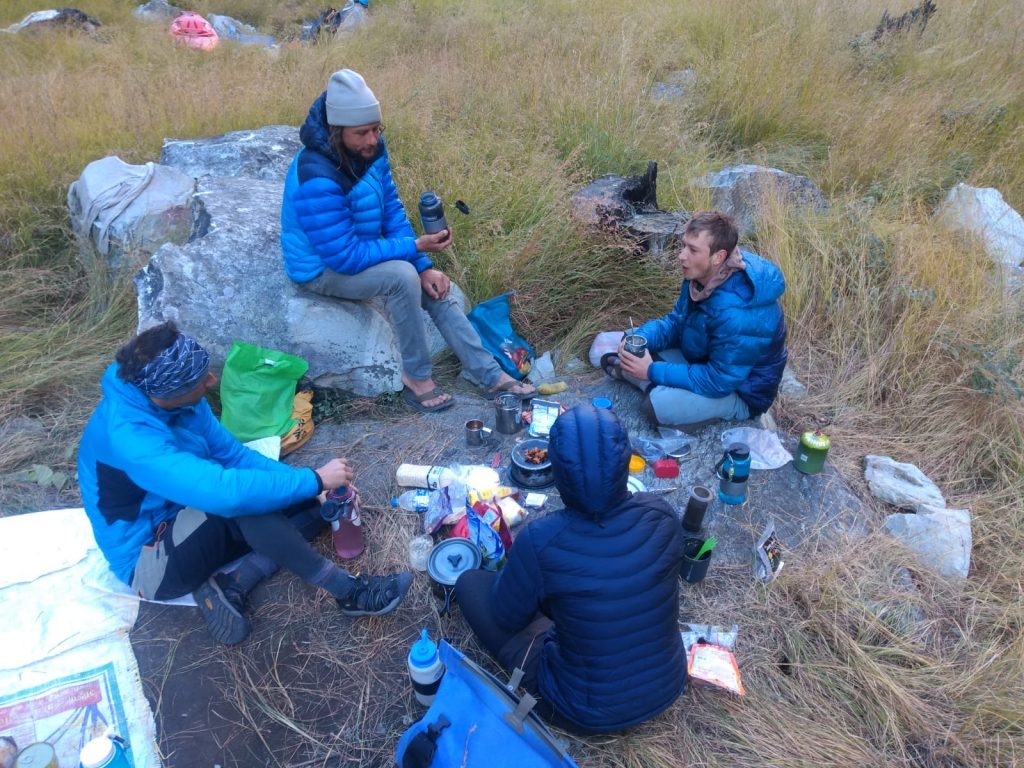
We pushed off around 9 had some chill class III for an hour to an hour and a half and then we reached the first portage of the day under a suspension bridge. We then continued down some class III/IV and reached the portage town just before lunchtime. After spending a few hours in the village coordinating with the locals, letting kids use our kayaks as see-saws, and eating daal bhat (rice and lentils) for lunch, we hopped in the back of a literal tractor-trailer that took us the 3-4 or so kilometers around the portage gorge. Dehydrated, hot, and tired, we made our way an additional kilometer or two to get back down to the river and were followed by a literal hoard of children. We then put on in the middle of a class IV+ rapid and boogied down the next section of mostly class IV+ rapids with some III interspersed. The character of the river changed again and was now big water class IV+. We got to camp around 4:30; a small rocky beach on river left.
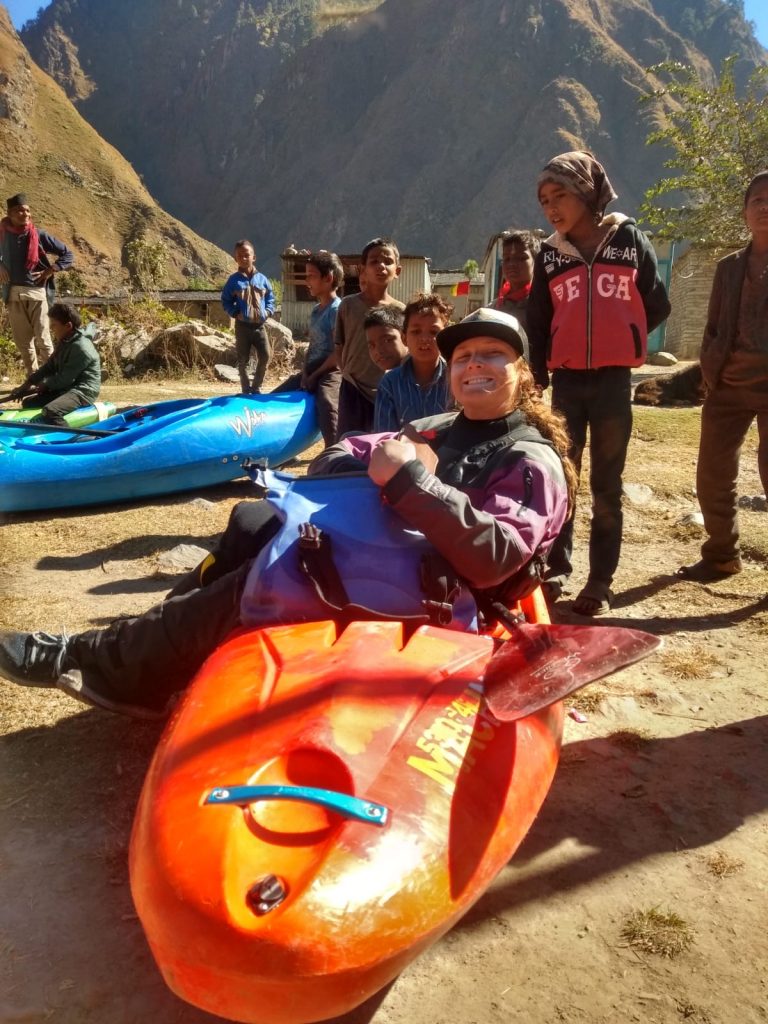
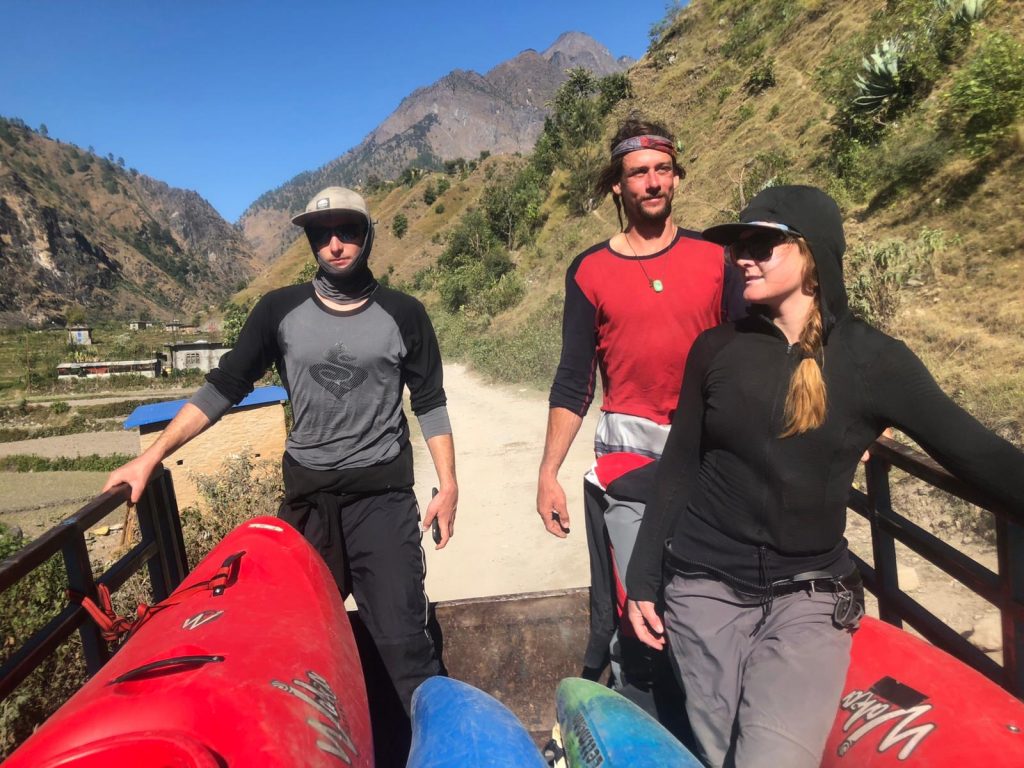
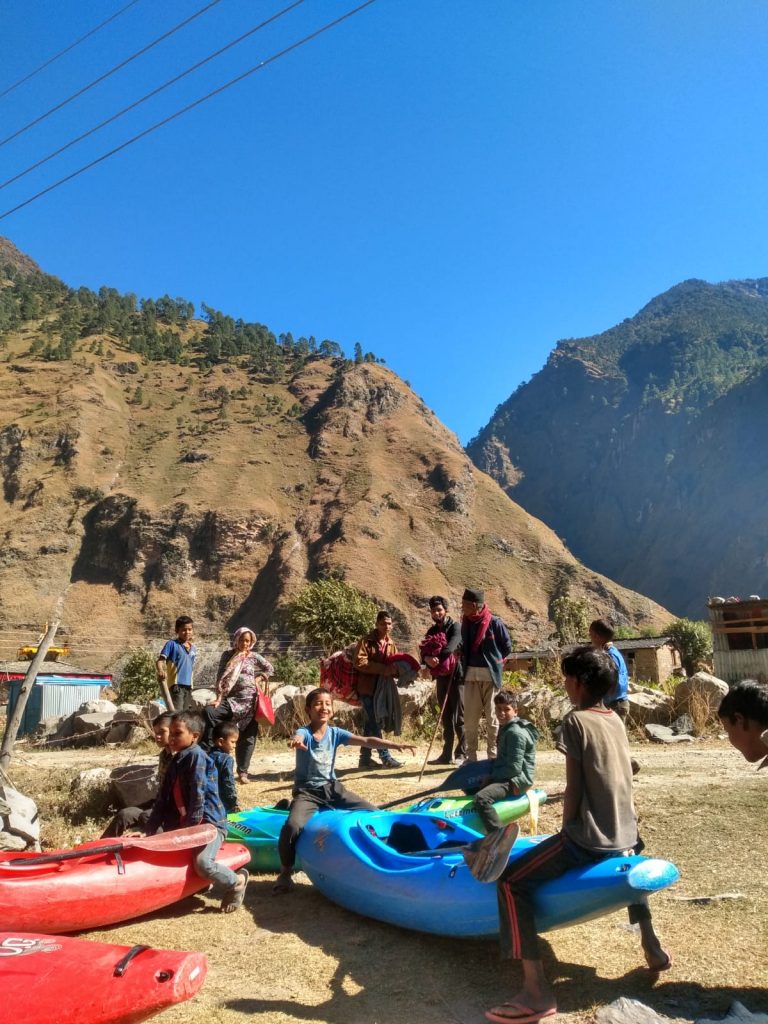
We got on the water around the same time as the other days but, unfortunately, I was sick. My stomach was really upset and I was extremely weak with every stroke making me feel like I had to puke. The day started with some class III but picked up significantly as the river changed character again becoming more gorged in and channelized. We soon reached some of the biggest and hardest rapids we had seen all trip, which was less than ideal seeing as I had the strength of a small child at that point and even making a class III ferry felt almost unattainable. We took it slowly and eventually reached a very steep boulder garden with massive boulders choking the river. Most of the flow went to the left, over what looks like would be a sweet boof at lower flows. At the flows we had, however, all the water pushed directly into a massive pothole that had been carved out of the Cliffside on river left. We elected to portage around the first two drops on river right and then put in just below to run a sneak line. The river continues in this fashion for a while with big boulder gardens. We portaged a few rapids in this section but I’m honestly not sure how many, I was pretty out of it. We ate lunch at another rapid that we portaged down the left and then seal launched back into the water and ferried hard, back to river right to scout the next blind drop around a left bend in the river. Thankfully, after finally being able to eat something and drinking a lot of water at lunch, I felt much better and had enough strength to paddle the continuous boulder gardens that remained below. The river eventually opened back up and returned to big water class IV and we were able to make pretty good time boat-scouting the rapids. We then camped on river right near a village and were greeted by a few groups of kids who hung around our fire for a while.
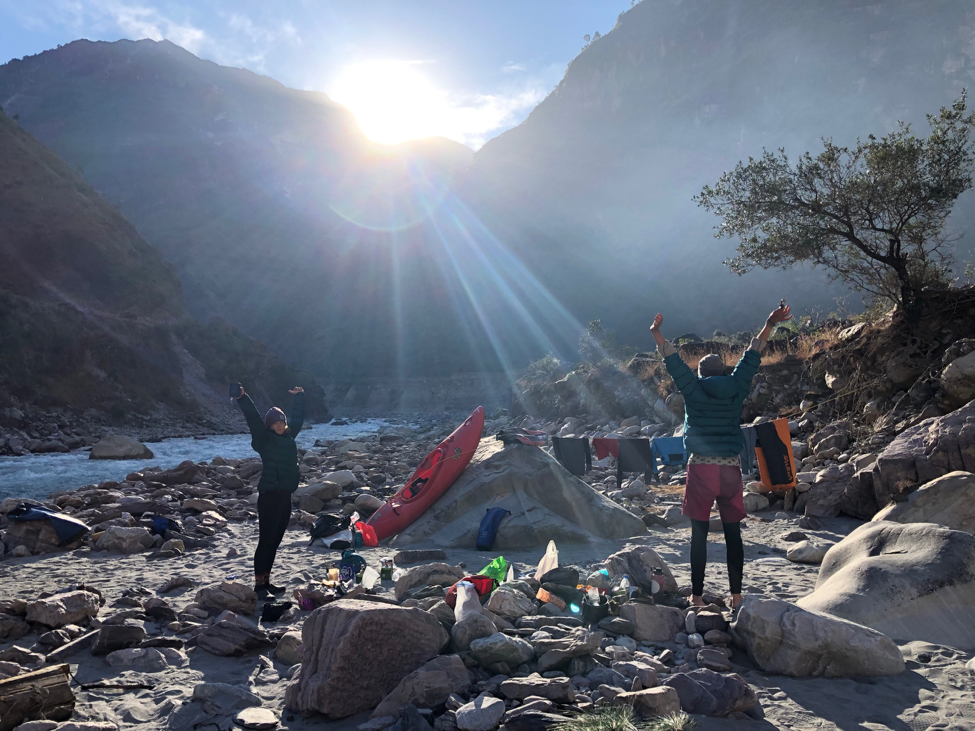
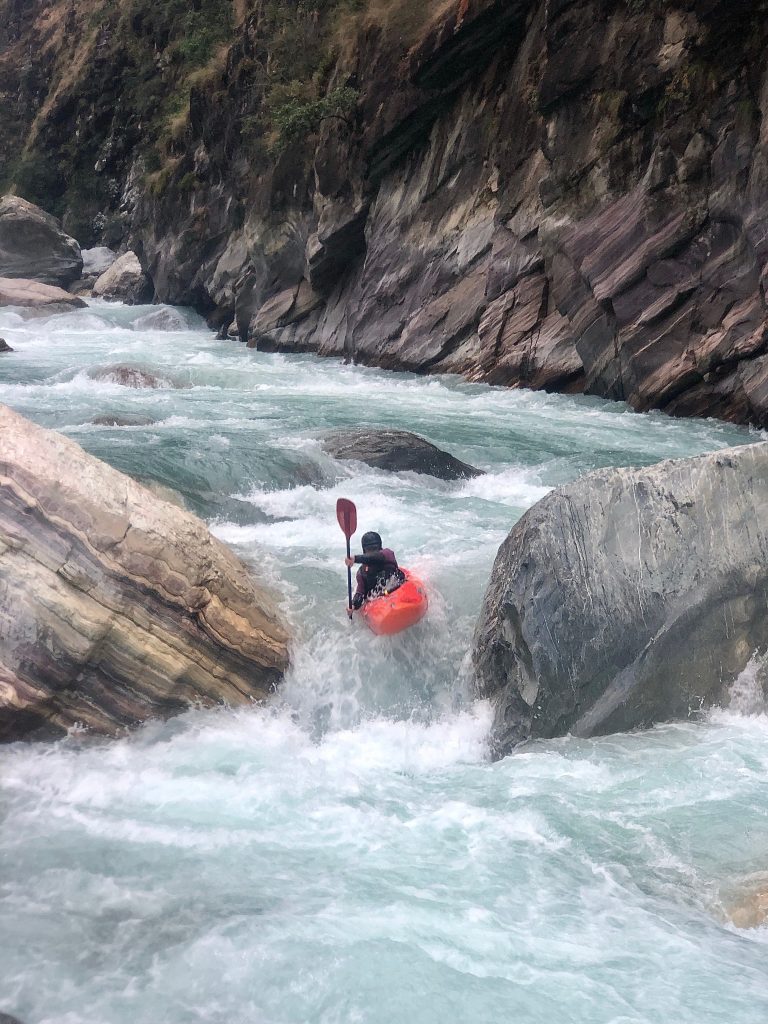
Our final day on the water was surprisingly chill with mostly class IV drops that were boat-scout-able. This was one of my favorite sections of the river with all of us just blue-angel-ing down stunning whitewater. Though I felt significantly better, it was Lukas’s turn to be sick. We took out around 4 in a small town just after a big cement bridge. We then ate some food and took the overnight bus back to Nepalgunj. This bus ride was the single worst bus ride I have ever taken in my entire life. Hands down. The bus was packed, there was no legroom, and a large number of people were puking. I started feeling sick again as the overnight bus rocketed down the dirt roads and had my own puking episode when we stopped for a few hours so our driver could take a nap. I, once again, was down for the count. Finally, we made it back to Nepalgunj where our plan was to take a jeep immediately back to Pokhara. Unfortunately, there was a strike occurring which meant that car travel was forbidden in daylight hours. So, we stayed in one of the dirtiest motels I’ve ever been in, but honestly, I didn’t care. I had just enough energy to drag myself to bed, where I then slept for essentially the entire day. That evening, we were finally able to hire a jeep to take us back to Pokhara and then eventually made our way back to Kathmandu.
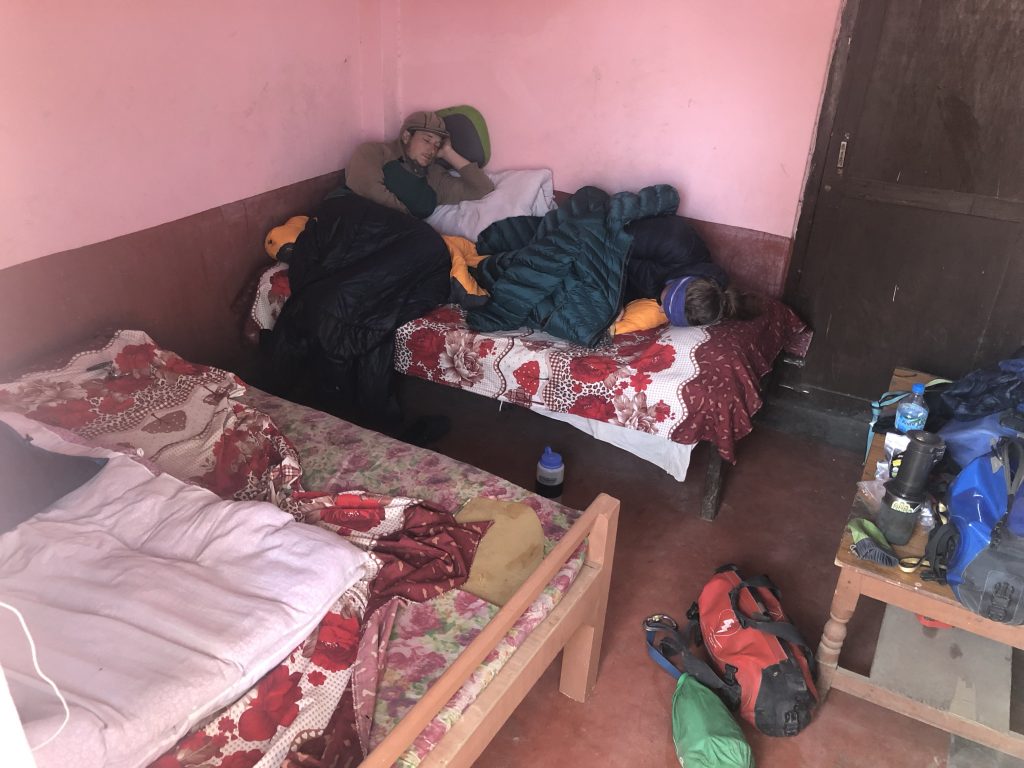
The Thuli Bheri is, by far, one of my favorite rivers in the entire world and the people that I did it with are absolutely incredible. I am forever indebted to them for making it all work and just being amazing people. We also had the help of sturdy and dependable gear from Watershed and Immersion Research. Nepal was an experience and a half and I learned so much more than I could ever put into words. Here’s to having more wild adventures in stunning places!
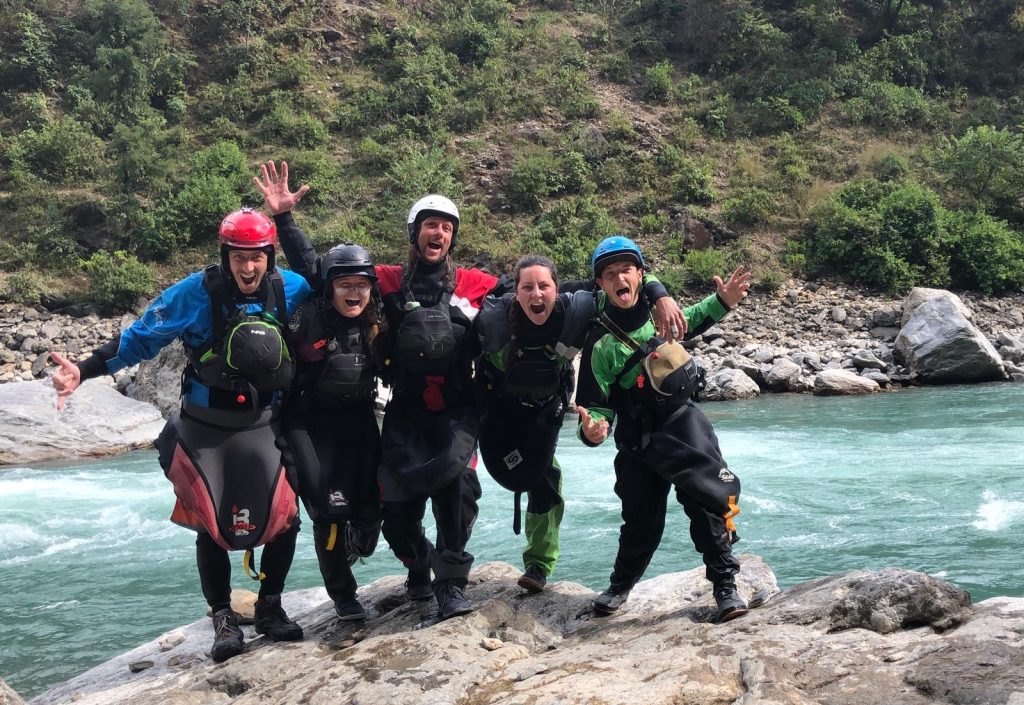
General info from the trip:
*As with everything in Nepal, the timing of these could vary significantly
- 6 hrs chartered mini bus from Kathmandu to Pokhara
- 12 hrs public bus from Pokhara to Nepalgunj
- 1 hr flight from Nepalgunj to Juphal
- 1 hr Jeep ride from Juphal to Suligad
- 6 days on the water
- 12 hr public bus from takeout to Nepalgunj
- 5 hr jeep from Nepalgunj to Pokhara
- 6 hrs chartered mini bus from Pokhara to Kathmandu
From what I can glean from other write-ups, we had healthy flows and relatively warm weather. If you had a super-sendy crew, you probably wouldn’t need to portage as much as we did, but there was definitely more class V than I was expecting. We didn’t skimp on the food that we brought, which made our boats really heavy, but I’m glad that we brought it all with us. Though we passed through a few small towns, there wasn’t very much in terms of the possibility of re-vamping our food supply. We brought lots of layers, anticipating cold weather, but didn’t really need that many; I’m assuming that later in November and certainly in early December, having those layers would be key. Though a lot of the river is technically class IV on its own, I’d rate the entire run as a whole at a IV+/V level with how continuous it is and how far away you are from any resources. This is a class IV ish run for a class V kayaker and would be extremely challenging for anyone with just class IV skills. Lukas made an awesome edit as well, if you’d like to get a bit more of a feel for the nature of the whitewater!
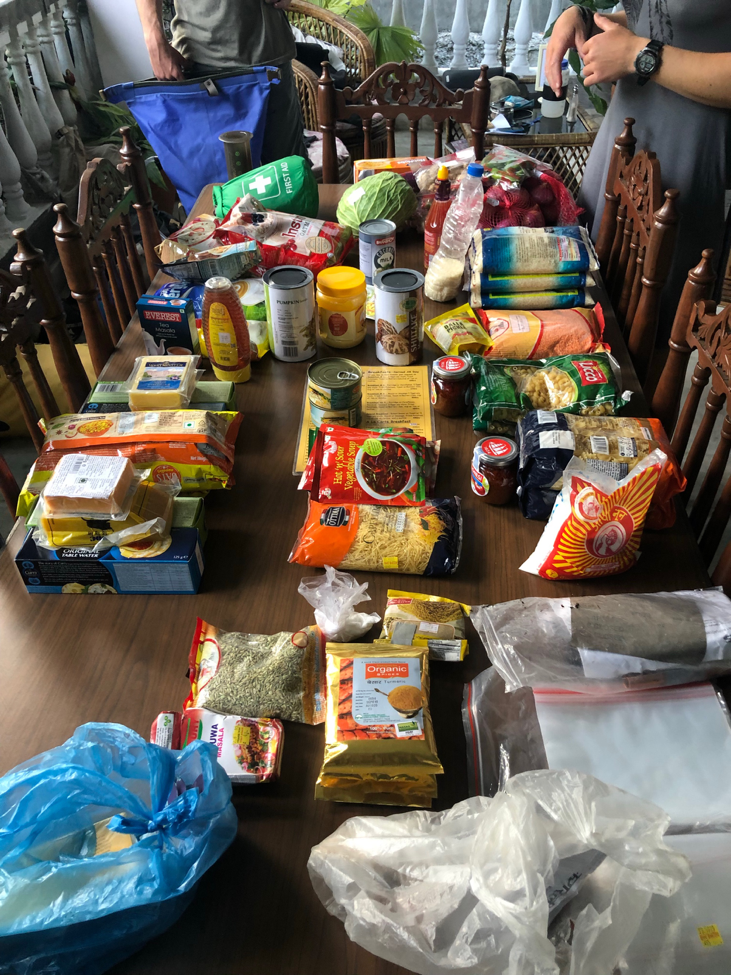




1 ping
10 best places to kayak in the world - My Blog says:
October 9, 2020 at 1:54 pm (UTC 1 )
[…] can also enjoy in Nepal the majestic Thuli Bheri and Balephi Khola, and you can use your boat to visit the tributaries of the […]